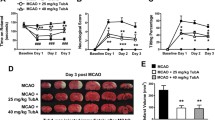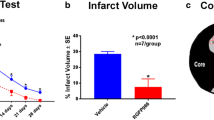Abstract
Histone deacetylase inhibitors (HDACi)—valproic acid (VPA) and trichostatin A (TSA) promote neurogenesis, neurite outgrowth, synaptic plasticity and neuroprotection. In this study, we investigated whether VPA and TSA promote post-ischemic neuroprotection and neuronal restoration in rat primary cortical neurons. On 6 days in vitro (DIV), cortical neurons were exposed to oxygen-glucose deprivation for 90 min. Cells were returned to normoxic conditions and cultured for 1, 3, or 7 days with or without VPA and TSA. Control cells were cultured in normoxic conditions only. On 7, 9, and 13 DIV, cells were measured neurite outgrowth using the Axiovision program and stained with Tunel staining kit. Microtubule associated protein-2 immunostaining and tunel staining showed significant recovery of neurite outgrowth and post-ischemic neuronal death by VPA or TSA treatment. We also determined levels of acetylated histone H3, PSD95, GAP 43 and synaptophysin. Significant increases in all three synaptic markers and acetylated histone H3 were observed relative to non-treated cells. Post-ischemic HDACi treatment also significantly raised levels of brain derived neurotrophic factor (BDNF) expression and secreted BDNF. Enhanced BDNF expression by HDACi treatment might have been involved in the post-ischemic neuroprotection and neuronal restorative effects. Our findings suggest that both VPA and TSA treatment during reoxygenation after ischemia may help post-ischemic neuroprotection and neuronal regeneration via increased BDNF expression and activation.







Similar content being viewed by others
References
Langley B, Gensert JM, Beal MF, Ratan RR (2005) Remodeling chromatin and stress resistance in the central nervous system: histone deacetylase inhibitors as novel and broadly effective neuroprotective agents. Curr Drug Targets CNS Neurol Disord 4(1):41–50
Xu WS, Parmigiani RB, Marks PA (2007) Histone deacetylase inhibitors: molecular mechanisms of action. Oncogene 26(37):5541–5552
Hu E, Dul E, Sung CM, Chen Z, Kirkpatrick R, Zhang GF, Johanson K, Liu R, Lago A, Hofmann G, Macarron R, de los Frailes M, Perez P, Krawiec J, Winkler J, Jaye M (2003) Identification of novel isoform-selective inhibitors within class I histone deacetylases. J Pharmacol Exp Ther 307(2):720–728
Hsieh J, Nakashima K, Kuwabara T, Mejia E, Gage FH (2004) Histone deacetylase inhibition-mediated neuronal differentiation of multipotent adult neural progenitor cells. Proc Natl Acad Sci USA 101(47):16659–16664
Di Daniel E, Mudge AW, Maycox PR (2005) Comparative analysis of the effects of four mood stabilizers in SH-SY5Y cells and in primary neurons. Bipolar Disord 7(1):33–41
Hall AC, Brennan A, Goold RG, Cleverley K, Lucas FR, Gordon-Weeks PR, Salinas PC (2002) Valproate regulates GSK-3-mediated axonal remodeling and synapsin I clustering in developing neurons. Mol Cell Neurosci 20(2):257–270
Hao Y, Creson T, Zhang L, Li P, Du F, Yuan P, Gould TD, Manji HK, Chen G (2004) Mood stabilizer valproate promotes ERK pathway-dependent cortical neuronal growth and neurogenesis. J Neurosci 24(29):6590–6599
Yamauchi J, Miyamoto Y, Murabe M, Fujiwara Y, Sanbe A, Fujita Y, Murase S, Tanoue A (2007) Gadd45a, the gene induced by the mood stabilizer valproic acid, regulates neurite outgrowth through JNK and the substrate paxillin in N1E—115 neuroblastoma cells. Exp Cell Res 313(9):1886–1896
Yuan PX, Huang LD, Jiang YM, Gutkind JS, Manji HK, Chen G (2001) The mood stabilizer valproic acid activates mitogen-activated protein kinases and promotes neurite growth. J Biol Chem 276(34):31674–31683
Gobbi G, Janiri L (2006) Sodium- and magnesium-valproate in vivo modulate glutamatergic and GABAergic synapses in the medial prefrontal cortex. Psychopharmacology 185(2):255–262
Li X, Ketter TA, Frye MA (2002) Synaptic, intracellular, and neuroprotective mechanisms of anticonvulsants: are they relevant for the treatment and course of bipolar disorders? J Affect Disord 69(1–3):1–14
Cunningham MO, Woodhall GL, Jones RS (2003) Valproate modifies spontaneous excitation and inhibition at cortical synapses in vitro. Neuropharmacology 45(7):907–917
Zhang MM, Yu K, Xiao C, Ruan DY (2003) The influence of developmental periods of sodium valproate exposure on synaptic plasticity in the CA1 region of rat hippocampus. Neurosci Lett 351(3):165–168
Vecsey CG, Hawk JD, Lattal KM, Stein JM, Fabian SA, Attner MA, Cabrera SM, McDonough CB, Brindle PK, Abel T, Wood MA (2007) Histone deacetylase inhibitors enhance memory and synaptic plasticity via CREB: CBP-dependent transcriptional activation. J Neurosci 27(23):6128–6140
Yasuda S, Liang MH, Marinova Z, Yahyavi A, Chuang DM (2009) The mood stabilizers lithium and valproate selectively activate the promoter IV of brain-derived neurotrophic factor in neurons. Mol Psychiatry 14(1):51–59
Bredy TW, Wu H, Crego C, Zellhoefer J, Sun YE, Barad M (2007) Histone modifications around individual BDNF gene promoters in prefrontal cortex are associated with extinction of conditioned fear. Learn Mem 14(4):268–276
Jeong MR, Hashimoto R, Senatorov VV, Fujimaki K, Ren M, Lee MS, Chuang DM (2003) Valproic acid, a mood stabilizer and anticonvulsant, protects rat cerebral cortical neurons from spontaneous cell death: a role of histone deacetylase inhibition. FEBS Lett 542(1–3):74–78
Kim HJ, Rowe M, Ren M, Hong JS, Chen PS, Chuang DM (2007) Histone deacetylase inhibitors exhibit anti-inflammatory and neuroprotective effects in a rat permanent ischemic model of stroke: multiple mechanisms of action. J Pharmacol Exp Ther 321(3):892–901
Wilot LC, Bernardi A, Frozza RL, Marques AL, Cimarosti H, Salbego C, Rocha E, Battastini AM (2007) Lithium and valproate protect hippocampal slices against ATP-induced cell death. Neurochem Res 32(9):1539–1546
Freidkin I, Herman M, Tobar A, Chagnac A, Ori Y, Korzets A, Gafter U (2010) Effects of histone deacetylase inhibitors on rat mesangial cells. Am J Physiol Renal Physiol 298(2):F426–F434
Eyal S, Lamb JG, Smith-Yockman M, Yagen B, Fibach E, Altschuler Y, White HS, Bialer M (2006) The antiepileptic and anticancer agent, valproic acid, induces P-glycoprotein in human tumour cell lines and in rat liver. Br J Pharmacol 149(3):250–260
Hummel TR, Wagner L, Ahern C, Fouladi M, Reid JM, McGovern RM, Ames MM, Gilbertson RJ, Horton T, Ingle AM, Weigel B, Blaney SM (2013) A pediatric phase 1 trial of vorinostat and temozolomide in relapsed or refractory primary brain or spinal cord tumors: a children’s oncology group phase 1 consortium study. Pediatr Blood Cancer 60(3):390–395
Friday BB, Anderson SK, Buckner J, Yu C, Giannini C, Geoffroy F, Schwerkoske J, Mazurczak M, Gross H, Pajon E, Jaeckle K, Galanis E (2012) Phase II trial of vorinostat in combination with bortezomib in recurrent glioblastoma: a north central cancer treatment group study. Neuro Oncol 14(2):215–221
Shein NA, Shohami E (2011) Histone deacetylase inhibitors as therapeutic agents for acute central nervous system injuries. Mol Med 17(5–6):448–456
Leker RR, Shohami E, Constantini S (2002) Experimental models of head trauma. Acta Neurochir Suppl 83:49–54
Bramlett HM, Dietrich WD (2004) Pathophysiology of cerebral ischemia and brain trauma: similarities and differences. J Cereb Blood Flow Metab 24(2):133–150
Lei Z, Ruan Y, Yang AN, Xu ZC (2006) NMDA receptor mediated dendritic plasticity in cortical cultures after oxygen-glucose deprivation. Neurosci Lett 407(3):224–229
Ay I, Sugimori H, Finklestein SP (2001) Intravenous basic fibroblast growth factor (bFGF) decreases DNA fragmentation and prevents downregulation of Bcl-2 expression in the ischemic brain following middle cerebral artery occlusion in rats. Brain Res Mol Brain Res 87(1):71–80
Dancause N, Barbay S, Frost SB, Plautz EJ, Chen D, Zoubina EV, Stowe AM, Nudo RJ (2005) Extensive cortical rewiring after brain injury. J Neurosci 25(44):10167–10179
Kim HJ, Leeds P, Chuang DM (2009) The HDAC inhibitor, sodium butyrate, stimulates neurogenesis in the ischemic brain. J Neurochem 110(4):1226–1240
Castro LM, Gallant M, Niles LP (2005) Novel targets for valproic acid: up-regulation of melatonin receptors and neurotrophic factors in C6 glioma cells. J Neurochem 95(5):1227–1236
Wu X, Chen PS, Dallas S, Wilson B, Block ML, Wang CC, Kinyamu H, Lu N, Gao X, Leng Y, Chuang DM, Zhang W, Lu RB, Hong JS (2008) Histone deacetylase inhibitors up-regulate astrocyte GDNF and BDNF gene transcription and protect dopaminergic neurons. Int J Neuropsychopharmacol 11(8):1123–1134
Chang YC, Rapoport SI, Rao JS (2009) Chronic administration of mood stabilizers upregulates BDNF and bcl-2 expression levels in rat frontal cortex. Neurochem Res 34(3):536–541
Ren M, Leng Y, Jeong M, Leeds PR, Chuang DM (2004) Valproic acid reduces brain damage induced by transient focal cerebral ischemia in rats: potential roles of histone deacetylase inhibition and heat shock protein induction. J Neurochem 89(6):1358–1367
Acknowledgments
This research was supported by Basic Science Research Program through the National Research Foundation of Korea (NRF) funded by the Ministry of Education, Science and Technology (2010–0025382 grant to DHC and 2012R1A1A4A010137 grant to JL).
Author information
Authors and Affiliations
Corresponding authors
Additional information
Mohammad Rakibul Hasan and Ji-Hye Kim have contributed equally to this work.
Rights and permissions
About this article
Cite this article
Hasan, M.R., Kim, JH., Kim, Y.J. et al. Effect of HDAC Inhibitors on Neuroprotection and Neurite Outgrowth in Primary Rat Cortical Neurons Following Ischemic Insult. Neurochem Res 38, 1921–1934 (2013). https://doi.org/10.1007/s11064-013-1098-9
Received:
Revised:
Accepted:
Published:
Issue Date:
DOI: https://doi.org/10.1007/s11064-013-1098-9




